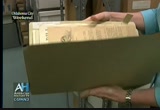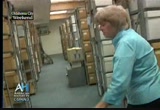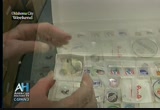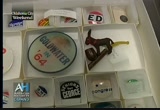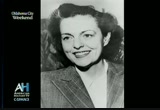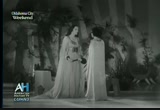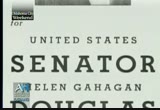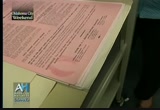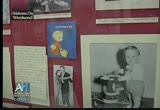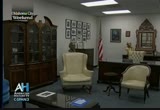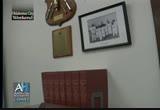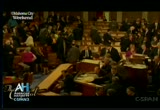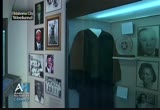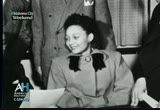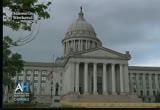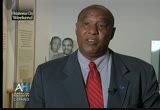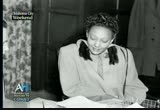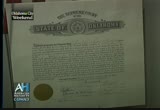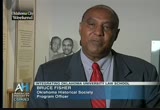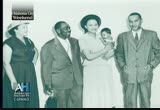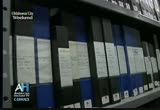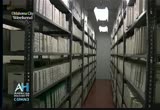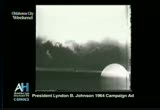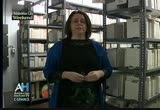tv [untitled] May 6, 2012 6:30pm-7:00pm EDT
6:30 pm
he also ran for president and was a very interesting character, as his name might suggest, alfalfa bill. he was involved in the pre-statehood convention that was held at a time in which there was interest in the possibility that oklahoma would become an indian state as opposed to a free state in 1904, and then of course we became a state in 1907, and he was one of the first governors. this is from his collection. alfalfa bill murray becomes the governor of the state of oklahoma in 1930. then he runs for president in 1932. here is an interesting piece. this is from his presidential campaign. it is a candy wrapper from candy bars he handed out on the
6:31 pm
campaign trail, 5 cents, and putting alfalfa bill before the voters. he also was quite the populist, here is his platform, the murray doctrine. the first point, i hold that civilization begins and ends with the plow, no government can stand without the freedom of the farmer, free from roe -- from oppression. he talks about the banking act and some financial institutions of the day, themes that are probably reminiscent today as well. >> how was he received as a candidate? >> he was seen as somewhat of a populist, more fringe candidate if you will than mainstream
6:32 pm
candidate. would have been running at the same time franklin delano roosevelt. we have paper in a lot of different forms. we also have audiovisual materials in our collection. that's a newer development that we're having to change some of our collection practices with. but we also have some memorabilia, which i think is often times of great interest to people who are interested in the collection. for example, here we have some of our collection buttons, political buttons. we were just talking about alfalfa bill murray. this button is probably the oldest in our collection. says the state of sequoia. which again was what was proposed as the name, should oklahoma not have entered as a free state but rather as indian
6:33 pm
state. so that's from probably around 1904. 1905. you have other presidential election campaigns that came as part of the collections as well as some of our own senators. here we have buttons of u.s. senator robert s. kerr, one of the significant leaders in the history of the state, was very involved after the depression era and dust bowl, literally transforming the landscape of this state with reservoirs and lakes throughout the state and soil conservation initiatives that really underscore our agricultural economy. >> how did these pins come to your collection? >> well, when we get a collection, sometimes it's somewhat organized, sometimes it is not terribly organized. but you'll -- the members will
6:34 pm
have as part of their collection some of these, this memorabilia, plaques, other sorts of things. and then sometimes we just have people that over the years know that we are in the business of preserving political history and they will offer to make donations to us. we generally do not purchase items for the collection, they are donated to the collection. some of these would have come from different collections, but they're preserved here in one. one of the things that the senate historian's office emphasizes to members is that you want to put your collection someplace where it has the capacity not only to preserve and keep your collection but also to process it and make it available to scholars. and that's why we think we urge many of our members here in the state of oklahoma to make their donations to us. one of the most interesting collections, one that gets used
6:35 pm
quite a bit, helen ka hayden douglas, served in the 1940s, was from california. what is interesting about her is that she was married to the hollywood actor, melvin douglas. served during the 1940s from california. had a very distinguished acting career. and so we actually have some of her stage photos, very imposing presence here. this is a promo photo from one film she made called "she." and actually the name of the character she played in this was she who must be obeyed. >> there will be slaves waiting without a wall to guide you in safety to your little world.
6:36 pm
>> it is probably more of a cult film now than well known film. has something to do with, you know, the fountain of youth and eternal light. >> how did she get involved in politics? >> she and her husband moved from the new york to the east coast, hollywood, and she got involved in the plight of migrant workers in california, her activism there also drew the attention of eleanor roosevelt. she became a democratic committee woman, ran for congress in the wartime era of world war ii. she went on then to try to aspire from her congressional career to run for the u.s. senate. she ran for the u.s. senate in 1950, and she ran against another congressman from the state of california, richard m. nixon.
6:37 pm
this was a very nasty campaign. you may remember that this is also the time of the beginning of the rise of the red scare. so one of the things that nixon accused helen kahagan douglas of was a voting record that was leaned towards the extreme left and communist party. and this is called the pink sheet. this was issued by the nixon campaign committee accusing her of many votes against the committee on unamerican activities and votes against the loyalty and security legislation, votes against california, and tying her voting record to a congressman in new york casting both of them as communists. note in the corner, the lipstick
6:38 pm
which we believe is from helen kahagan douglas was her response to this pink sheet that was being put out by the opposition. she was unsuccessful. richard nixon did win that campaign, and she did not run for another elected office after that. so her primary tenure was in the congress. this is an exhibit space where we have rotating exhibits. this particular one is about david elborn, served as governor, u.s. senator and now president of university of oklahoma. one note of significance, we also have the papers of his father, lyle born, and recently the retiring congressman, dan born signed a deed to commit his papers here. so we have three generations of the born family in terms of their paper. you can kind of see that the
6:39 pm
range of things that are in the collection, from official correspondence and clearly political papers to those things that are more personal and nonpolitical from everything from notes and cards, over here we have another exhibit of materials from young constituents, children that write to congressmen, send them handwritten letters. you have both insight into the personal lives of members as well as the official activities that they were involved in. the most significant part of the center's physical setting is a replica of the speaker's office. this is the 46th speaker of the u.s. house of representatives, and the space itself had
6:40 pm
furniture and pictures and memorabilia from his capitol office right off the house of representatives, as well as the office for his district in oklahoma. and we've tried to maintain here many of the important memorabilia from his collection. i would just point out a couple things that are particularly significant. this display cabinet has 50 pens in it, which reflect the great society programs that mr. albert played a key role as both majority leader and then whip, working with president johnson to enact what we have come to know as the great society initiatives. it really is symbolic of the legislative agenda. there's only one other collection like this in texas.
6:41 pm
he was from humble roots. a little town called bug tussle down in southeastern oklahoma. but this is a little league team from elmore city, a little town in that neck of the woods, and mcalester was considered his home. when he left the congress, he retired to mcalester. he didn't stay in washington, he didn't go on to lobby or do something, you know, to make more money. he really saw himself returning to his roots. one other thing, he was not a tall man, which is why he is known as the little giant from little dixie, which is the name we give to southeastern oklahoma. he was 5'4". and if you look under the desk
6:42 pm
here, you can see he has a little stool. that's his original stool to lift his feet up to elevate the chair, be a little more of an imposing feature behind the desk. but he certainly lived up to his nickname of the little giant from little dixie. >> why collect all these items, the papers, the physical items? why is that important? >> well, certainly we think of this center as a living tribute to the importance of representative democracy, and if you don't honor that history, if you don't preserve that history, we are poorer for it, in terms of understanding this important institution in our government. certainly right now congress is not held in high esteem by many
6:43 pm
people, but the health of our representative institutions is something that we need to care about as a society. and so part of what we do at the carl albert center in terms of that preservation and also in terms of civic engagement activities that we undertake is to remind people that we cannot neglect these important institutions. hosted by cox communications cable partner, cspan's local content vehicles recently visited many historic sites in oklahoma city, the capitol of oklahoma. learn more about oklahoma city all week long on american history tv. we are at the african-american exhibit at the oklahoma history center. this is the first permanent exhibit of the first african-american experience. strangely enough, over 500
6:44 pm
museums and historical societies in oklahoma. when this exhibit opened in 2005, it was oklahoma's first permanent exhibit of the african-american experience. and it covers everything from the preterritorial days until civil rights movement to the present day accomplishments of african americans. this was my mother. the first african-american to be admitted to university of oklahoma school of law. 1946, when laws in oklahoma prohibited african-americans and whites from even going to the same schools together, sitting in the same classrooms together, they were dual separate educational systems in oklahoma. she was the first person to try to breakdown those barriers and did it by applying to university school of law. had to be rejected because the oklahoma laws and constitution prohibited african-americans from going to school with whites, but in doing so, it set up a supreme court decision that in 1948 said basically that she had a right to get a legal education in oklahoma as soon as anybody else has a right to get a legal education in oklahoma.
6:45 pm
it did not end separate but equal, but certainly put the dual educational system on trial. she had a pretty good lawyer, thur good marshall. he was there for the naacp defense fund. naacp decided that nationally they were going to try to bring an end to segregated education. throughout the united states, they were looking for cases that could get into the supreme court. so my mom had just graduated from college in 1945, and she was valedictorian from her class from high school. she was an honor student at langston university. the president of the local naacp knew my family. my mom happened to be in the room when they were discussing it. so she agreed to be the plaintiff. they went and applied for admission on january the 14th, 1946. and she was rejected. they began the legal process. that legal process took from then until january of 1948, two
6:46 pm
years, to actually work itself through the legal process. the case was first started in norman, oklahoma at the county level, and she lost there, tan was appealed to oklahoma supreme court where she lost there. and then they appealed that to the united states supreme court. the supreme court ruled unanimously that she should have that opportunity in oklahoma. my mom was real excited about that, she was at the supreme court when they had the arguments. and so she came back to oklahoma, real excited, thinking she was getting ready to go to law school. within seven days, the school, admission period would end, and she gotta tell gram in the mail that said that oklahoma had just opened the langston university school of law, so within seven days, they created a law school, a separate law school, just for her. the school was located in the state capitol building, and they hired two part time attorneys and part time dean, and that was to be the separate but equal law
6:47 pm
school for her to attend. and she did not attend that law school at all. but the law school stayed open a full year. meantime, the head of the oklahoma state naacp, roscoe dungy, came up with another strategy. he said i have six other students to apply to university of oklahoma. one in engineering, one in medicine, one in architecture, geology and several other disciplines. let me see you build those schools overnight. oklahoma knew at that point the deal was up, they couldn't afford to have a dual, separate educational system in oklahoma. not only oklahoma, but every other state supported education had the same priority. up until that time, states used what they called the out of state tuition claim. this was a plan where if african-americans wanted to study a discipline that wasn't available in their state at the historically black colleges, they would offer to pay some stipend to go out of state to
6:48 pm
attend school. they were using that for decades. but this supreme court decision basically brought end to that, saying that wasn't good enough. they deserved a chance to have education within the state at a state supported school. that brought an end to the dual education system in higher education. once admitted to ou, that didn't end everything because she was admitted on segregated basis. state law still applied. in my mom's case, they had all the other students in the law school to come to the front of the class. they had theater style seating. it was like sitting in a theater, walk in, step up a row. they put all the other students at the front, lower part, front of the class. at the top of the classroom in the very back, they put a single chair with a sign saying colored, and a chain around it, to represent a separate classroom. wasn't a separate classroom, that was their representation of a separate classroom. that's the conditions in which my mom was actually admitted to oklahoma university law school.
6:49 pm
and she was admitted in summer of 1949. and she said that she could not have survived that first summer class had it not been for the white men in law school that helped her at the time. i say men, she was not only the only african-american at the law school at that time, she was also the only woman in summer session in law school at that time. but the other students would take her outside under the shade trees where the laws did not apply and they shared their notes with her, they shared their books with her, helped her to get through the first summer session. from that point on, she was on her own. she knew that after all the effort that she had gone through to get in law school, all of the people that contributed so much to enable her to get in law school, she knew once admitted, her job was to get out of law school. but that was a point in time when it was all on her, and she carried a huge burden to try and successfully complete law school, and she did. she graduated in 1951, and
6:50 pm
august of 1951, and became a lawyer. in 1992, the whole circle closed. and he appointed my mom to the board of regents, to the university of oklahoma. interestingly enough, even though african-americans have been an integral part of this nation, our history and our culture has not been incorporated into the mainstream of american history. and so it was the case in oklahoma. i grew up in oklahoma, not knowing a great deal about my mother's case. not -- i knew of the case, and i knew people treated her differently and special. but i was not getting that affirmation in high school. never studied about it in high school. but i knew about it. i grew up hearing my mom talk about giants in her life, like thurgood marshall, like rascal dungy, like james nevrit. she said she had the first dream team of lawyers. and i grew up understanding how great these people were, but she
6:51 pm
was never bragging about herself. and i was a senior -- no, i was a freshman in college. and she asked me to accompany her to a funeral in tulsa, oklahoma. so i drove her to the funeral in tulsa, and it happened it be at the funeral of one of the lawyers on her legal team. amos t. hall, he was the oklahoma resident attorney. and so we were standing outside of the church on our way into the church, and i heard my mom say, "thurgood." and then i saw mr. marshall turn around, and he said silt, which was her nickname and grabbed her and hugged her. and on the way back, i said, what was that all about? and then she told me what it was all about. so at that point, i really realized how significant that court battle was. up until then, she was just mom. i mean, she was -- and my friends, you know -- have all been shocked in the last decade, because they have learned so much more about my mother since we have opened this museum here at the oklahoma historical society and talk about her here, and she gets a lot of
6:52 pm
recognition in oklahoma. but up until then, she was just mom. she made the best popcorn balls, and that's what everybody thought. that she was so special in that way. but now they have so much more appreciation for how important she is in american history. all weekend long, american history tv is joining our cox communications partners in oklahoma city to show its rich history. learn more about oklahoma city and c-span's local content vehicles at c-span.org/localcontent. we continue now our look at oklahoma city, this is american history tv on c-span3. >> at the julienne p. commercial archive and i'm terry and welcome to our space. previously, the ads were all on analog tape. those are stored here in this room. and you'll note it's a little chilly.
6:53 pm
we keep the temperature and humidity down for preservation of the analog materials. >> how far back does your collection date? >> we have audio material dating back to the 1930s for radio advertisements to the 1950s for television advertisements. some of our earliest material are commercials from the eisenhower campaign. [ nain a [ no audio ]
6:54 pm
[ no audio ]. >> one of the ways we get ads has been if ad agencies are going digital, and wish to get rid of their old analog copies, we're starting to see a lot more donations because a lot of them don't want to throw away a lifetime worth of analog tapes. so they send them to us. that's been a fantastic way we've gotten donations recently as well. >> what type of political advertisements do you have in this collection? >> just about every type. we have ads from positive imagery and negative imagery of candidates to ads discussing the issues at hand. issues that have changed over the course of many decades, but many relevant patterns still stay the same. negative advertising. concern with "flip-flopping" positions, establishing a candidate's value and so forth.
6:55 pm
>> what type of races? >> everything from local races all the way up to presidential. we do focus on north american, united states ads, but we do have some foreign spots as well. but the bulk of the 95,000-plus commercials in our collection are united states political commercials. this is our equipment storage room, and this is our refrigerator, where we keep our film canisters. i'll just pop that open very briefly so you can take a look inside. >> what type of commercials would be on these film? >> these are primarily our older presidential campaign commercials. a lot of this is the original material that started the archive when julian canter began obtaining it and collecting it in the late '50s. he'd been volunteering for the adelaide stevenson campaign, and during that time he'd made a lot of political contacts as well as contacts through his television work.
6:56 pm
and he realized that a lot of these old advertisements and reels were getting thrown out. so he convinced his contacts to give them to him and began the collection in the '50s. and when it was purchased by the university of oklahoma in 1985 it contained about 25,000 commercials, and it's grown today to over 95,000. >> you had mentioned negative campaigning. when did that become more precedent in these commercials? >> that has actually been the case in almost every campaign. some of the earliest material we have is negative campaigning. we've got ads from adlai stevenson against eisenhower. we have the famous daisy girl ad that was against goldwater. it's very easy in the visual medium of a short television ad to connect things with powerful imagery. >> ten, nine, eight, seven, six, five, four, three, two, one,
6:57 pm
zero. >> these are the stakes. to make a world in which all of god's children can live or to go into the dark. we must either love each other or we must die. >> vote for president johnson on november 3rd. >> you also see patterns of flip-flopping. we have several commercials from the famous john kerry windsurfing ad through to -- we have one called the carter cartoon that has a caricature of president carter flip-flopping. >> he promised to create more jobs, and now there are 8 million americans out of work. he promised to balance the budget. what he gave us was a $61 billion deficit. he promised not to raise taxes, but taxes have risen more than 70%. the time is now for strong leadership.
6:58 pm
reagan for president. >> you see in the changes of political advertisements over time not just changes in political approaches, which actually have pretty continuous patterns, but you also see changes in the culture that is used to kind of capture people's attention. the old i like ike jingles. we have one that features a lounge singer singing a song. quite a few of the old jingle ads that are kind of long and wouldn't hold people's attention today but were very popular at the time. ♪ i have a man who knows what to do and he gets to be the prez ♪ ♪ i love the gov, the governor of illinois ♪ ♪ he is the gov that brings the dove of peace and joy ♪ ♪ when illinois the gop double-cross ♪ ♪ he is the one who told all the crooks get lost ♪ ♪ adlai, love you madly
6:59 pm
♪ and what you did for your own great state ♪ ♪ you're gonna do for the rest of the 48 ♪ ♪ didn't know much about him before he came ♪ ♪ but now my heart's a ballot that bears his name ♪ ♪ because i listened to what he had to say ♪ ♪ i know that on election day ♪ we're gonna choose the gov that we love ♪ ♪ he is the gov nobody can shove ♪ ♪ we'll make the gov the president of the you, the me, and the usa ♪ >> if you look at current ads, rick santorum, for example, did a pop-up video style ad in the nature of vh1. so you can kind of see reflections of american culture being used to promote various candidates.
140 Views
IN COLLECTIONS
CSPAN3 Television Archive
Television Archive  Television Archive News Search Service
Television Archive News Search Service 
Uploaded by TV Archive on

 Live Music Archive
Live Music Archive Librivox Free Audio
Librivox Free Audio Metropolitan Museum
Metropolitan Museum Cleveland Museum of Art
Cleveland Museum of Art Internet Arcade
Internet Arcade Console Living Room
Console Living Room Books to Borrow
Books to Borrow Open Library
Open Library TV News
TV News Understanding 9/11
Understanding 9/11